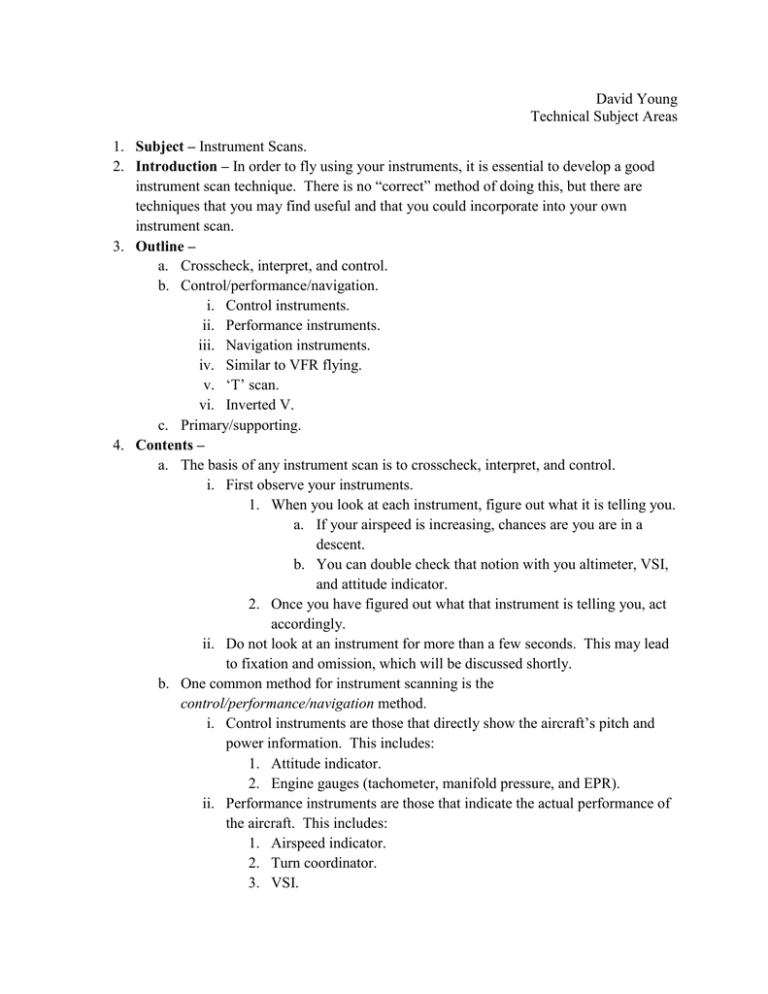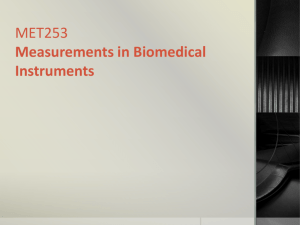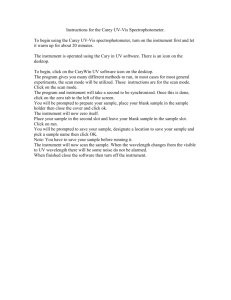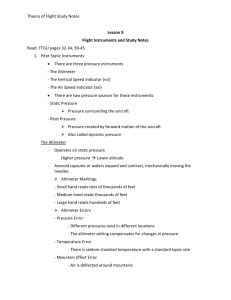Instrument Scans
advertisement

David Young Technical Subject Areas 1. Subject – Instrument Scans. 2. Introduction – In order to fly using your instruments, it is essential to develop a good instrument scan technique. There is no “correct” method of doing this, but there are techniques that you may find useful and that you could incorporate into your own instrument scan. 3. Outline – a. Crosscheck, interpret, and control. b. Control/performance/navigation. i. Control instruments. ii. Performance instruments. iii. Navigation instruments. iv. Similar to VFR flying. v. ‘T’ scan. vi. Inverted V. c. Primary/supporting. 4. Contents – a. The basis of any instrument scan is to crosscheck, interpret, and control. i. First observe your instruments. 1. When you look at each instrument, figure out what it is telling you. a. If your airspeed is increasing, chances are you are in a descent. b. You can double check that notion with you altimeter, VSI, and attitude indicator. 2. Once you have figured out what that instrument is telling you, act accordingly. ii. Do not look at an instrument for more than a few seconds. This may lead to fixation and omission, which will be discussed shortly. b. One common method for instrument scanning is the control/performance/navigation method. i. Control instruments are those that directly show the aircraft’s pitch and power information. This includes: 1. Attitude indicator. 2. Engine gauges (tachometer, manifold pressure, and EPR). ii. Performance instruments are those that indicate the actual performance of the aircraft. This includes: 1. Airspeed indicator. 2. Turn coordinator. 3. VSI. Young 2, Scans 4. Altimeter. 5. Directional gyro. 6. Magnetic compass. iii. Navigation instruments are those used for navigation. This includes: 1. Omni-bearing selector (OBS). 2. Horizontal situation indicator (HSI). 3. Automatic Direction Finder (ADF). 4. Global Position Satellite (GPS). iv. Just like with VFR flying, we want to establish our pitch/bank, trim the aircraft, cross-check with the instruments to make sure we are getting the desired performance, and make any adjustments necessary. 1. However, we must now use our attitude indicator instead of the actual horizon to help us establish our pitch attitude and bank angle. 2. We also adjust power using known power settings that work for what we are trying to accomplish. a. After setting our power, we reference the other instruments to make sure we are getting the performance we want out of the aircraft. 3. To make our lives easier, we trim the aircraft to keep it as stable as possible. 4. Finally, we make any adjustments after cross-checking all of our performance and navigation instruments. v. A common scan technique for control/performance/navigation is the ‘T’ scan. 1. This involves using the attitude indicator as the intersection of the ‘T’ and branching left to the airspeed indicator, back to the attitude indicator, then to the directional gyro, back to the attitude indicator, then to the altimeter. vi. Another scan technique for control/performance/navigation is the inverted ‘V’. 1. This involves using the turn coordinator for bank information, then going up to the attitude indicator for pitch and bank information, then to the VSI for pitch information. c. Another common technique is the primary/supporting scan. i. This uses a primary instrument for a certain maneuver as the main focus, which is backed up by supporting instruments. ii. The following is a table of the different primary and supporting instruments for different maneuvers: Young 3, Scans Maneuver Straight and level Pitch Bank Power Primary Supporting ALT AI, VSI HI AI, TC ASI MP and/or RPM Primary Supporting ALT AI, VSI HI AI, TC MP and/or RPM ASI Primary Supporting ALT AI, VSI AI TC ASI MP and/or RPM Primary Supporting ALT AI, VSI TC AI ASI MP and/or RPM Primary Supporting Transition to constant A/S climb Primary Supporting Straight constant A/S climb Primary Supporting Constant rate stabilized climb Primary Supporting ALT AI, VSI TC AI ASI ASI AI ASI, VSI HI AI, TC MP and/or RPM ASI ASI AI, VSI HI AI, TC MP and/or RPM ASI VSI AI HI AI, TC ASI MP and/or RPM Level airspeed changes Establishing a level turn Stabilized turn Turning airspeed change iii. This table seems daunting, but is mostly just common sense. This will also come with experience. d. Some common issues with scan techniques include fixation and omission. i. When most pilots begin instrument training, they tend to fixate on one or two instruments (many times the attitude indicator and altimeter). ii. To fix this, you will need to constantly remind yourself to keep your eyes moving. 1. Also, remember that other instruments have important information that you need to look at every so often as not doing so can lead to unusual attitudes and/or disorientation. 5. Evaluation – a. The student can explain the basis of all instrument flying. b. The student can explain the control/performance/navigation scan technique. c. The student can explain the primary/supporting scan technique. d. The student can identify ways of combating common scan errors. 6. References – a. Instrument Flying Handbook, Ch. 4. Young 4, Scans









